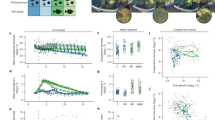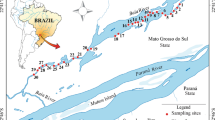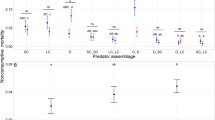Summary
The zooplankton community of a small pond changed markedly with temporal variation in predation pressure. Long term changes in zooplankton community structure occurred following the replacement of planktivorous fish by phantom midge (Chaoborus americanus) larvae as the predominant predator of zooplankton. The interannual changes following the establishment of Chaoborus included the apparent or near extinction, of species ill adapted to the new predation pressure and the successful colonization of well adapted species. Seasonal changes in the species composition and size distribution of the zooplankton community correlate with temporal variation in predation intensity associated with temperature-activity patterns of the predator or changes in the stage structure of the predator population.
Similar content being viewed by others
References
Allan JD (1973) Competition and the relative abundances of two cladocerans. Ecology 54:484–498
Anderson RS, Raasveldt LG (1974) Gammarus and Chaoborus predation. Occ Pap can Wildlife Serv 18:1–23
Black R (1976) The effects of grazing by the limpet, Acmaea insessa, on the kelp, Egregia laevigata, in the intertidal zone. Ecology 57:265–277
Begon M, Mortimer M (1986) Population Ecology: a unified study of animals and plants (Sec ed). Sinauer Associates Inc. Publishers, Sunderland, Mass.
Begon M, Harper JL, Townsend CR (1986) Ecology: individuals, populations and communities. Sinauer Associates Inc. Publishers, Sunderland, Mass.
Bengtsson J (1987a) Smaller zooplankton species are not superior in exploitative competition: a comment on Persson. Am Nat 129:928–931
Bengtsson J (1987b) Competitive dominance among Cladocera: are single factor explanations enough? An examination of experimental evidence. Hydrobiologia 145:245–257
Bradshaw WE (1969) Major environmental factors inducing the termination of larval diapause in Chaoborus americanus Johannsen. Biol Bull 136:2–8
Bradshaw WE (1970) Interaction of food and photoperiod in the termination of larval diapause in Chaoborus americanus. Biol Bull 139:476–484
Bradshaw WE (1973) Homeostasis and polymorphism, in vernal development of Chaoborus americanus. Ecology 54:1247–1259
Brewer R (1979) Principles of Ecology. W. B. Saunders Co. Philadelphia
Brooks JL, Dodson SI (1965) Predation, body size, and composition of plankton. Science 150:28–35
Colinvaux P (1986) Ecology. John Wiley and Sons Inc. New York
DeBernardi R, Guissani G (1975) Population dynamics of three cladocerans of Lago Maggiore related to predation pressure by a planktophagus fish. Verh int Ver Limnol 19:2906–2912
DeMott WR, Kerfoot WC (1982) Competition among cladocerans: nature of the interaction between Bosmina and Daphnia. Ecology 63:1949–1966
Dodson SI (1972) Mortality in a population of Daphnia rosea. Ecology 53:1011–1023
Dodson SI (1974) Zooplankton competition and predation: an experimental test of the size efficiency hypothesis. Ecology 55:605–613
Dodson SI (1984) Predation of Heterocope septentrionalis on two species of Daphnia: morphological defenses and their cost. Ecology 65:1249–1257
Dodson SI, Edwards C, Wiman F (1976) Zooplankton: specific distribution and food abundance. Limnol Oceanogr 21:309–313
Drenner RW, McComas SR (1980) The role of zooplankter escape ability and fish size selectivity in the selective feeding and impact of planktivorous fish. In: Kerfoot WC (ed) Evolution and Ecology of Zooplankton Communities. The University Press of New England, Hanover (N.H.):587–593
Drenner RW, de Noyelles F, Kettle D (1982) Selective impact of filter-feeding gizzard shad on zooplankton community structure. Limnol Oceanogr 27:965–968
Duggins DO (1980) Kelp beds and sea otters: an experimental approach. Ecology 61:447–453
Edmondson, WT (1959) Fresh-water Biology. John Wiley and Sons, Inc. New York
Ende CN von (1979) Fish predation, interspecific predation, and the distribution of two Chaoborus species. Ecology 60:119–128
Ende CN von, Dempsey DO (1981) Apparent exclusion of the cladoceran Bosmina longirostris by invertebrate predator Chaoborus americanus. Am Mid Nat 105:240–248
Federenko AY (1975) Feeding characteristics and predation impact of Chaoborus (Diptera, Chaoboridae) larvae in a small lake. Limnol Oceanogr 20:250–259
Frost BW (1974) Feeding processes at lower trophic levels in pelagic communities. In: Miller CB (ed) The biology of the ocean Pacific. Oregon State University: 59–77
Galbraith MG (1967) Size-selective predation on Daphnia by rainbow trout and yellow perch. Trans am Fish Soc 96:1–10
Goldman CR, Morgan MD, Threlkeld ST, Angeli N (1979) A population dynamics analysis of the cladoceran disappearance from Lake Tahoe, California-Nevada. Limnol Oceanogr 24:289–297
Grygierek E, Hillbricht-Ilkowska A, Spodniewska I (1966) The effect of fish on plankton community in ponds. Verh Int Ver Limnol 16:1359–1366
Hairston NG Sr (1987) Community ecology and salamander guilds. Cambridge University Press. New York: p 230
Hairston NG Jr, Munns W Jr (1984) The timing of copepod diapause as an evolutionarily stable strategy. Am Nat 123:733–751
Hairston NG Jr, Walton WE (1986), Rapid evolution of a life history trait. Proc Natl Acad Sci 83:4831–4833
Hairston NG Jr, Walton WE, Li KT (1983) The causes and consequences of sex-specific mortality in a freshwater, copepod. Limnol Oceanogr 28:935–947
Hall DJ (1964) An experimental approach to the dynamics of a natural population of Daphnia galeata medotae. Ecology 45:94–111
Harper JL (1969) The role of predation in vegetational diversity. Brookhaven Symp Biol 22:48–62
Havel JE, Dodson SI (1984) Chaoborus predation on typical and spined morphs of Daphnia pulex: behavioral observations. Limnol Oceanogr 29:487–494
Hebert PDN, Loaring JM (1980) Selective predation and the species composition of arctic ponds. Can J Zoo 58:422–426
Hrbacek J (1962) Species composition and the amount of zooplankton in relation to the fish stock. Rozpr csl Akad Ved 10:1–116
Hutchinson BP (1971) The effect of fish predation on the zooplankton of ten Adirondack lakes, with particular reference to the alewife, Alosa pseudoharengus. Trans Am Fish Soc 100:325–335
Inouye DS, Byers GS, Brown JH (1980) Effects of predation and competition on survivorship, fecundity, and community structure of desert annuals. Ecology 61:1344–1351
Kerfoot WC (1975) The divergence of adjacent populations. Ecology 56:1298–1313
Kerfoot WC (1977a) Implications of copepod predation. Limnol Oceanogr 22:316–325
Kerfoot WC (1977b) Competition in cladoceran communities: the cost of evolving defenses against copepod predation. Ecology 58:303–313
Kerfoot WC, Pastorok RA (1978) Survival versus competition: evolutionary compromises and diversity in zooplankton. Verh Int Verein Limnol 20:362–374
Kettle D, O'Brien WJ (1978) Vulnerability of arctic zooplankton species to predation by small lake trout (Salvelinus namaycush). J Fish Res Bd Can 35:1495–1500
Kormondy EJ (1984) Concepts of ecology (Third Edition). Prentice-Hall Inc. Englewood Cliffs, New Jersey
Krebs CJ (1985) Ecology: the experimental analysis of distribution and abundance (Third Edition) Harper and Row, New York
Kreuger DA, Dodson SI (1981) Embryological induction and predation ecology in Daphnia pulex. Limnol Oceanogr 26:219–223
Lane PA (1979) Vertebrate and invertebrate predation intensity of freshwater zooplankton communities. Nature 380:391–392
Lazzaro X (1987) A review of planktivorous fishes: their evolution, feeding behaviours, selectivity and impacts. Hydrobiologia 146:97–167
Lederer RJ (1984) Ecology and Field Biology. Benjamin/Cummings Publ. Co, Inc, Menlo Park, California
Lynch M (1978) Complex interactions between natural coexploiters-Daphnia and Ceriodaphnia. Ecology 59:552–564
McNaughton SJ, Wolf LL (1979) General Ecology. Holt, Rinehart and Winston, N.Y.
Menge BA (1976) Organization of the New England rocky intertidal community: role of predation competition, and environmental heterogeneity. Ecol Monogr 46:355–393
Morgan MD, Threlkeld ST, Goldman CR (1978) Impact of the introduction of Kokanee (Oncorhynchus nerka) and opossum shrimp (Mysis relicta) on an alpine lake. J Fish Res Bd Can 35:1572–1579
Neill WE (1975) Experimental studies of microcrustacean competition, community composition and efficiency of resource utilization. Ecology 56:809–826
Neill WE (1981) Impact of Chaoborus predation upon the structure and dynamics of a crustacean zooplankton community. Oecologia 48:164–177
Neill WE (1984) Regulation of rotifer densities by crustacean zooplankton in an oligotrophic montane lake in British Columbia Oecologia 61:175–181
Nilsson NA (1972) Effects of introductions of salmonids into barren lakes. J Fish Res Bd Can 29:693–697
Nilsson NA (1985) Consequences of the rotenone treatment of a subarctic swedish lake on the fish and zooplankton communities. Rep Inst Freshw Res Drottningholm 62:120–127
O'Brien WJ (1979) The predator-prey interaction of planktivorous fish and zooplankton. Am Scientist 67:572–581
O'Brien WJ, Schmidt D (1979) Arctic Bosmina morphology and copepod predation. Limnol Oceanogr 24:564–568
O'Brien WJ, Slade NA, Vinyard GL (1976) Apparent size as the determinant of prey selection by bluegill sunfish (Lepomis macrochirus). Ecology 55:1042–1052
O'Brien WJ, Kettle D, Riessen H, Schmidt D, Wright D (1980) Dimorphic Daphnia longiremis: predation and competitive interactions between the two morphs. In: Kerfoot WC (ed) Evolution and Ecology of Zooplankton Communities. The University Press of New England, Hanover (N.H.):497–505
Odum EP (1983) Basic Ecology. Saunders College Publishing, Philadelphia
Paine RT (1966) Food web complexity and species diversity. Am Nat 100:65–75
Pastorok RA (1980) Selection of prey by Chaoborus larvae: a review and new evidence of behavioral flexibility. In: Kerfoot WC (ed) Evolution and Ecology of Zooplankton Communities. The University Press of New England, Hanover (N.H.):538–554
Pennak RW (1978) Fresh-water invertebrates of the United States. John Wiley and Sons, Inc, New York.
Persson R (1985) Asymmetrical competition: are larger animals competitively superior? Am Nat 126:261–266
Richards RC, Goldman CR, Frantz TC, Wickwire R (1975) Where have all the Daphnia gone? The decline of a major cladoceran in Lake Tahoe, California-Nevada. Verh Int Verein Limnol 19:835–842
Richman S, Dodson SI (1983) The effect of food quality on feeding and respiration by Daphnia and Diaptomus. Limnol Oceanogr 28:948–956
Ricklefs RE (1983) The Economy of Nature (Second edition). Chiron Press Inc. New York
Risch SJ, Carroll (1982) Effects of a keystone predaceous ant, Solenopsis geminata, on arthropods in a tropical agroecosystem. Ecology 63:1979–1983
Saether OA (1970) VI. Chaoboridae. Die Binnengewässer 26:257–280
Sih A, Crowley P, McPeek M, Petranka J, Strohmeier K (1985) Predation, competition, and prey communities: a review of field experiments. Ann Rev Ecol Syst 16:269–311
Smith DW, Cooper SD (1982) Competition among Cladocera Limnol Oceanogr 63:1004–1015
Smith R (1980) Ecology and Field Biology (Third ed). Harper and Row Publishers, New York
Swift MC, Federenko AY (1975) Some aspects of prey capture by Chaoborus larvae. Limnol Oceanogr 20:418–425
Tessier AJ (1986) Comparative population regulation of two planktonic cladocera (Holopedium gibberum and Daphnia catawba). Ecology 67:285–302
Tessier AJ, Goulden CE (1982) Estimating food limitation in cladoceran populations. Limnol Oceanogr 27:707–717
Thorp JH (1986) Two distinct roles for predators in freshwater assemblages. Oikos 47:75–82
Threlkeld ST (1986) Resource-mediated demographic variation during the midsummer succession of a cladoceran community. Freshwater Biology 16:673–683
Threlkeld ST, Rybock JT, Morgan MD, Folt CL, Goldman CR (1980) The effects of an introduced invertebrate predator and food resource variation on zooplankton dynamics in an ultraoligotrophic lake. In: Kerfoot WC (ed) Evolution and Ecology of Zooplankton Communities. The University Press of New England (N.H.):555–568
Vanni MJ (1986) Competition in zooplankton communities: Suppression of small species by Daphnia pulex. Limnol Oceanogr 31:1039–1056
Vinyard GL (1980) Differential prey vulnerability and predator selectivity: effects of evasive prey on bluegill (Lepomis macrochirus) and pumpkinseed (L. gibbosus) predation. Can J Fish Aq Sci 37:2294–2299
Walton WE (1986) the influence of the predaceous midge larva Chaobrus on the composition of pond communities. PhD dissertation. University of Maryland. p 128
Walton (1988) The influence of zooplankton defenses on prey selection by young Chaoborus larvae. J Plank Res 10:101–114
Warshaw SJ (1972) Effects of alewives (Alosa pseudoharengus) on the zooplankton of Lake Wononskopomuc, Connecticut. Limnol Oceanogr 17:816–825
Wells L (1970) Effects of alewife predation on zooplankton populations in Lake Michigan. Limnol Oceanogr 15:556–565
Wright DI, O'Brien WJ (1984) The development and field test of a tactical model of the planktivorous feeding of white crappie (Pomoxis annularis). Ecol Monogr 54:65–98
Zaret TM (1980) Predation and freshwater communities. Yale University Press, New Haven: p 187
Ziebell CD, Tash JC, Barefield RL (1986) Impact of threadfin shad on macrocrustacean zooplankton in two Arizona lakes. J Freshwater Ecology 3:399–406
Author information
Authors and Affiliations
Rights and permissions
About this article
Cite this article
Black, R.W., Hairston, N.G. Predator driven changes in community structure. Oecologia 77, 468–479 (1988). https://doi.org/10.1007/BF00377262
Received:
Issue Date:
DOI: https://doi.org/10.1007/BF00377262




